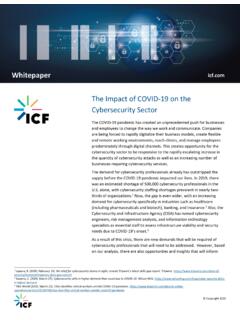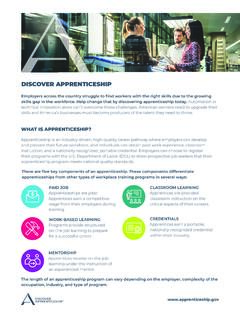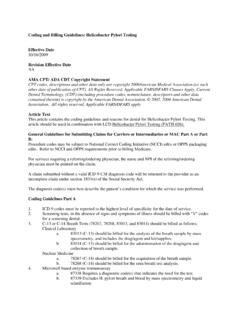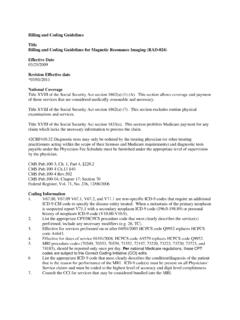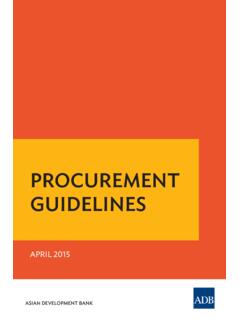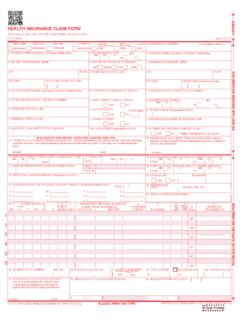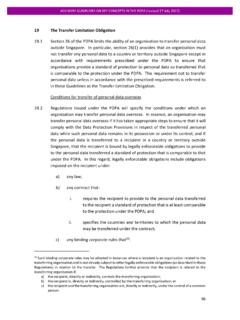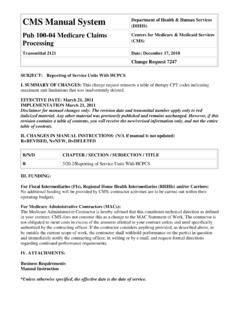Transcription of The Federal Resources Playbook for Registered Apprenticeship
1 The Federal Resources Playbook for Registered ApprenticeshipEMPLOYMENT AND TRAINING ADMINISTRATION UNITED STATES DEPARTMENT OF LABORTABLE OF CONTENTSI ntroduction Department of Labor: Federal Workforce Funds for Apprenticeship : The Workforce Innovation and Opportunity Act 1 Overview 1 Program Eligibility 2 Innovative Use of Federal Funds to Support Apprenticeship 3 Workforce Professionals 3 Resources Department of Education: Federal Student Aid Funds: Title IV Student Aid including Pell Grants and Federal Work Study 5 Overview 5 Program Eligibility 6 Innovative Use of Federal Funds to Support Apprenticeship 6 Resources Department of Veterans Affairs: GI Bill and Veterans Programs in Apprenticeship 7 Overview 7 Program Eligibility 8 Innovative Use of Federal Funds to Support Apprenticeship 8 Other VA Services 8 Resources Department of Agriculture: Supplemental Nutrition Assistance Program: Employment and Training Programs 10 Overview 10 Program Eligibility 11 Innovative Use of Federal Funds to Support Apprenticeship 11 Resources Department of Transportation.
2 Federal Highway Administration: On-the-Job Training and Supportive Services Program 12 Overview 12 Program Eligibility 12 Resources Department of Housing and Urban Development: Section 3 Covered Housing and Urban Development Financial Assistance Programs 13 Overview 13 Program Eligibility 14 Innovative Use of Federal Funds to Support Apprenticeship 14 Resources 14 United States Department of Labor iACKNOWLEDGMENTS: A special thanks to Corporation for a Skilled Workforce, the National Governors Association Center for Best Practices and the following Federal agencies who assisted in the update of this guide: Department of Education, Department of Labor, Department of Veterans Affairs, Department of Agriculture, Department of Transportation, and Department of Housing and Urban represents a valuable investment in skills that can put workers on a proven path to the middle class while getting the job done for employers and businesses looking to grow and workforce and education funds can help many businesses undertake new investments in Apprenticeship , encourage more employers to provide high-skilled training opportunities for apprentices, and assist educators and intermediaries in strengthening the tie between training and employment through guide provides information for companies, employers, labor, Apprenticeship sponsors, educators, workforce professionals, intermediaries .
3 And community-based organizations on using the following Federal funds and Resources to support Apprenticeship : IF YOU ARE: A company or an employer hoping to make starting or expanding an Apprenticeship more affordable A college or training provider looking to strengthen partnerships or to build new partnerships with employers in your area A state or local workforce system looking to expand apprenticeships in your area and increase the number of workers on a path to the middle class A community-based organization or nonprofit intermediary looking for Resources to assist workers in entering and excelling in an Apprenticeship This guide is for you!ii United States Department of Department of Labor: Federal Workforce Development Funds, including Workforce Innovation and Opportunity Act, Trade Adjustment Act, H1B and Women in Apprenticeship in Non-Traditional Department of Agriculture: Supplemental Nutrition Assistance Program Education and Training Department of Education: Federal Student Aid Funds, Title IV Student Aid including Pell Grants and Federal Work Department of Transportation: Federal Highway Administration On-the-Job Training and Supportive Services Department of Veterans Affairs: GI Bill and Veterans Affairs Educational Department of Housing and Urban Development: Financial Assistance Programs Department of Labor.
4 Federal Workforce Funds for ApprenticeshipThe Workforce Innovation and Opportunity ActOverviewFederal workforce development funds can be used to encourage employers to invest in Registered Apprenticeship Programs (RAP) and Industry-Recognized Apprenticeship Programs (IRAP), and to prepare workers for and support them in Apprenticeship . For the purposes of this Playbook , the term Apprenticeship refers to both Apprenticeship Programs, which combine paid-work experience with education, are validated by the Department of Labor or a State Apprenticeship Agency, leading to a certificate of completion from that agency. The Federal RAP system was created in 1937; today there are over 23,000 programs in the United States. In an effort to expand the model to new industries, the Department of Labor in 2015 launched the American Apprenticeship Initiative (AAI), awarding $175 million to earn-and-learn partnerships across the country.
5 These partnerships between employers, organized labor, non-profits, local governments, and educational institutions have expanded the RAP model to new sectors, from transportation and advanced manufacturing to health care and information technology, registering over 24,000 new apprentices. Since the launch of the first AAI grants, the Department has invested in state and competitive grants to continue Apprenticeship expansion Apprenticeship Programs are high-quality Apprenticeship programs recognized by industry or workforce leaders designated by the Department of Labor. Similar to RAPs, IRAPs include a paid-work experience and an educational component, resulting in an industry-recognized credential. They provide opportunities to obtain workplace-relevant knowledge and progressively advancing skills. IRAPs can be developed or delivered by entities such as trade and industry groups, corporations, non-profit organizations, educational institutions, unions or joint labor-management organizations.
6 IRAP apprentices are paid, but pay increases are not required as in RAPs; programs must make clear what wages will be paid and under what circumstances the pay will increase. Workforce development funds are limited, but employers and Apprenticeship programs are eligible to receive these funds. Funding decisions are made at the state and local levels. The Workforce Innovation and Opportunity Act (WIOA) encourages the workforce system to work with employers to use Apprenticeship to put workers on a path to high-skill, middle class careers. United States Department of Labor 1 Workforce system Resources that can be used to support Apprenticeship include:}Assistance with training and tuition costs. Local Workforce Development Boards (WDBs) and AmericanJob Centers (AJCs) set policy on allowable Apprenticeship costs for eligible individuals.
7 Individual TrainingAccounts (ITAs) can cover the allowable amount of job-related instruction costs, including costs related toclassroom instruction and distance learning. Due to COVID-19, this can also cover additional expenses suchas software and equipment to support remote learning for eligible dislocated workers or employed workersdetermined to need training. Similarly, Customized Training Contracts between local WDBs or AJCs andemployers can pay for Apprenticeship instructional costs.}Support for training expenses. Depending on state and local policy, On-the-Job-Training contracts canreimburse employers up to 75 percent of wage rates paid to participants for up to six months.}Coverage for supervision and extraordinary training costs. On-the-Job-Training contracts can also covera portion of the supervision and extraordinary training costs associated with overseeing a new apprentice,equivalent to 75 percent of the apprentice s wage rate.
8 }Provision of additional recruiting, placement, and support services. The workforce system can also covera range of career services, including pre- Apprenticeship training and assistance in recruiting and placingapprentices, as well as support services such as transportation, books, supplies, and childcare.}Flexibility for upskilling incumbent workers may be leveraged by Apprenticeship . WIOA permits localWorkforce Development Boards to use a small percentage of their funds for incumbent worker operating Apprenticeship programs can leverage these dollars to help train their current workers.}Other DOL Resources : In addition to Office of Apprenticeship Resources and WIOA formula funding, TradeAdjustment Act funding can reimburse employers for training workers that have been laid off because offoreign trade; H1B funding is aimed at training American workers and reducing dependence on foreignlabor; Women in Apprenticeship and Non-Traditional Occupations (WANTO) grants can be used to supportapprenticeship EligibilityWIOA may be utilized to pay for training apprentices, including:} Incumbent Worker Training (to pay for training/instruction of currentapprentices);} Customized Training (for eligible instruction costs);} On-the-Job Training (OJT) contracts (to pay for employer sextraordinary costs of training); and} Individual Training Accounts (to pay for training/instruction of newapprentices).
9 Under WIOA, an Apprenticeship program seeking funds to support participants must be on the Eligible Training Provider List (ETPL). Registered Apprenticeship Programs are, by definition, considered eligible; IRAPs must apply to be on the ETPL like all other training providers. To become an eligible training provider, Apprenticeship programs apply to their local Workforce Development Board. }Funding amounts are determined by the local Workforce Development Board or American Job Center.} Contact your local Workforce Development Board or American Job Center for more details on availability offunding to support your Apprenticeship program and to find the talent your organization needs here: United States Department of LaborApprenticeship programs can help local workforce system entities including Workforce Development Boards and American Job Centers meet important workforce system performance is a proven model to help job seekers immediately start working and increase their skills and earnings, and an effective strategy for connecting with businesses in diverse fields and meeting their workforce needs.
10 In addition to successfully meeting the needs of employers and job seekers, partnerships with Apprenticeship programs can positively impact workforce system outcomes across many key measures such as: } Employment An Apprenticeship is a job, so job seekers enter employment when they begin an Apprenticeship program. } Retention Apprenticeship programs have high retention rates. The vast majority of apprentices retain employment after the program ends. } Earnings Graduates earn an average of $70,000 per year. } Credential Attainment Apprentices earn a national, industry- recognized credential upon ProfessionalsUsing Federal Workforce Funding to Support Participants in ApprenticeshipApprenticeship is a proven training strategy that helps businesses thrive by generating highly skilled and productive employees while helping workers start new careers offering higher addition, by connecting workers and employers through a proven training strategy, Apprenticeship can strengthen local workforce systems overall significantly increasing performance on critical metrics like employment, earnings, measurable skill gains, credential attainment.

